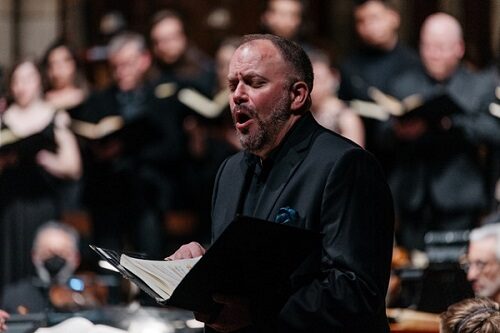 United States Bach, St. Matthew Passion: Thomas Cooley (Evangelist), Jonathan Woody (Jesus), The Saint Thomas Choir of Men and Boys, The Choir of Trinity Wall Street, Trinity Youth Chorus, New York Baroque Incorporated, Trinity Baroque Orchestra / Dana Marsh (conductor). Saint Thomas Church, New York, 29.4.2022. (RP)
United States Bach, St. Matthew Passion: Thomas Cooley (Evangelist), Jonathan Woody (Jesus), The Saint Thomas Choir of Men and Boys, The Choir of Trinity Wall Street, Trinity Youth Chorus, New York Baroque Incorporated, Trinity Baroque Orchestra / Dana Marsh (conductor). Saint Thomas Church, New York, 29.4.2022. (RP)

‘[T]here is nothing like it in all of music’ is how Leonard Bernstein described Bach’s St. Matthew Passion. Now considered a masterpiece, its beginnings were somewhat more humble. Composed for liturgical purposes at St. Thomas Church in Leipzig, the St. Matthew was first heard there on Good Friday in 1727, and was performed only a handful of times during Bach’s life. He revised it repeatedly, and the version that he created for Good Friday in 1736 has become the standard source for contemporary performances.
After Bach’s death in 1750, the St. Matthew Passion lapsed into obscurity, until Mendelssohn was given a copy of it by his grandmother. At the age of twenty, Mendelssohn conducted a highly successful performance in March 1829, which is regarded as one of the seminal events in the history of Western Music.
For the St. Matthew, Bach wrote for two choirs and orchestras, in addition to soloists and continuo, which were placed in St. Thomas Leipzig’s two facing organ lofts. These were the forces assembled by St. Thomas Fifth Avenue and Trinity Wall Street for an exceptional performance of Bach’s masterwork. Beyond the musical experience, however, the concert was a celebration of the centuries-old musical traditions of the two preeminent Episcopal churches and their resilience in face of the challenges posed by the pandemic.
St. Thomas Fifth Avenue’s choir of men and boys is renowned for its excellence. Founded in 1919, Saint Thomas Choir School is one of three of its kind in the world, and the only one in the United States. Dating to at least the middle of the eighteenth century, the Choir of Trinity Wall Street may be the oldest chorus in the US and performs not only as a church ensemble but also as a professional concertizing and recording group. Both of the churches’ musical forces excel in the Baroque sphere.

The Trinity Wall Street Choir and Trinity Baroque Orchestra were placed on one side of St. Thomas Fifth Avenue’s imposing chancel with its magnificent reredos, and The Saint Thomas Choir of Men and Boys and New York Baroque were on the other. The Trinity Youth Chorus sang the ripieno soprano lines in the opening and closing choruses of Part I. They stood in the south gallery for the opening chorus, ‘Kommt, ihr Töchter, helft mir klagen’, adding to the sonic splendor of this majestic chorus.
Dana Marsh, who trained as a boy chorister at Saint Thomas Choir School and at Salisbury Cathedral in England, led the performance. In those movements where coordination was key, he led with authority. During some of the solos, however, he simply stood still. The first among equals in shaping the musical and emotional contours of the performance, Marsh readily yielded to the musical impulses of virtuosi as skilled as he.
Tenor Thomas Cooley as the Evangelist has a beautiful voice and extraordinary communicative skills, and his narration brought to life the immediacy, intensity and intimacy of Jesus’s betrayal and death. As Jesus, Jonathan Woody, a member of the Trinity Choir, was youthful and commanding in both voice and appearance. His bass-baritone was at its most impressive when he sang Jesus’s command to his disciples at the Last Supper to eat the bread and wine that he offered them.
The soloists were drawn from the two choirs. From the Saint Thomas Choir, treble Francis Segger sang a moving ‘Blute nur, du liebes Herz’ and Jonathan May, with his clear, penetrating countertenor, was particularly effective in expressing the gravity running through the recitative and aria ‘Erbarm es, Gott! Hier steht der Heiland angebunden…Können Tränen meiner Wangen’.
Many of the soloists ornamented the vocal line, but soprano Madeline Apple Healey from the Trinity Choir was exceptionally skilled and effective in doing so in ‘Ich will dir mein Herz Schenken’. Healey was radiant as she graced the reprise of the opening section with ornaments of special delicacy, invention and charm. In ‘Buss und Reu’, countertenor Timothy Parsons, also from the Trinity Choir, produced a perfect imitation of tears through precise and beautiful droplets of sound.
In the St. Matthew, the obbligato instruments are equal partners with the voices, and the instrumental forces for this performance were drawn from the ranks of the finest Baroque specialists. The music flowing from the flutes and oboes was buoyant and captivating, but it was the playing of the two concertmasters, Robert Mealy of Trinity Baroque Orchestra and Beth Wenstrom of NY Baroque, as well as gamba player Matt Zucker (also from the Trinity troupe), that was the most mesmerizing.
The emotional apex of the performance came immediately after the death of Jesus with bass-baritone Enrico Lagasca’s singing of ‘Mache dich, mein Herze rein’. It is one of the wonders of the St. Matthew Passion how Bach expressed the meaning of the simplest of texts, often childlike in their directness and innocence, in music so profound. Lagasca’s singing of the many repetitions of ‘Ich will Jesus selbst begraben’ in the aria, accompanied by the plaintive sounds of two oboe da caccia, was an outpouring of devotion and grief as elegant as it was moving.
Rick Perdian